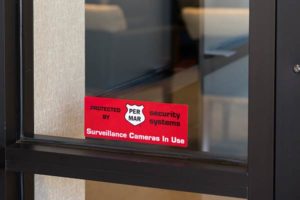Physical Security Series Part 5: Building Security
February 10, 2020
The goal of our Physical Security Blog Series has been to weed out any and all stranger danger at every phase of entering your property. For our final blog post in the series, all that’s left is your offense once any lurking danger is in the building (that is, if any intruders manage to make it past your perimeter security, parking security, environmental design and lobby security measures). You’ve come this far so we encourage you to check out our building security tips below!
Security Assessment + Plans
Whether you decide to outsource your business’ security or keep it in-house, there should be a plan that is made known to all employees. Before that plan can be created, it’s recommended to assess the situation. A full security assessment will help identify any existing and upcoming areas of weakness. Regular assessments allow business owners to bring and keep security measures up to date.
Once you know what you’re working with – the number of elevators, entry doors and windows, types of employees or former employees, and other foot traffic – your company’s security plans can be drawn up. If implementing the changes at once is too costly, they can be done in phases over time. But keep in mind it’s not necessary to overdo it. Stick to what you need.
People, Technology, or Both?
Once you decide whether to keep security in-house or outsource it, you’ll then want to decide on your approach. Will you utilize people (security officers, mobile patrol, etc.), technology (cameras, burglar alarms, access control, etc.), or a combination of both?
People
Having a people-driven approach provides a sense of safety to the people on your property, both actual and perceived. Like security cameras, security guards also act as a built-in deterrent. If it makes sense for your facility to hire security officers, then there are several considerations to factor in. To name a few:
- Is there a need for security officers 24/7 or only during the evening or high traffic hours?
- Is your campus large enough to hire one or more mobile patrol officers?
- Are there situations where temporary officers would be needed?
Technology
Below are the top forms of business security technology:
- Security Cameras & Intelligent Video Monitoring
- Burglar Alarms
- Access Control
- Business Automation – including the ability to view and control everything from your computer and/or smartphone
That being said, you want to be sure you know how to use it or security technology may be of little value to you. For example, CCTV cameras can be a great asset unless nobody knows how to use them (e.g. knowing how to find useful recordings or installing multiple cameras that toggle at random and don’t catch the necessary events). Instead, stick to event-based recordings that activate your camera when an alarm goes off.
Your business alarm system is most useful when everyone knows how to use it and it’s set to the beat of your business. Choose something that is custom-designed to meet the demands of your business and its daily operations. Your security assessment will have helped you determine high traffic times and also low traffic times, which can leave your business and/or employees vulnerable, for example.
Keep in mind that burglar alarms and security cameras are much more effective when they are monitored by a professional monitoring center that can verify the alarm or event 24/7, this also helps to reduce false alarms.
Access control is great for keeping all internal areas of your business secure when managed properly. To do so, assign a dedicated employee or outsourced company to review the access control logs, collect key cards from terminated or resigning employees, and change the passwords when necessary.
Isn’t it time for that added peace of mind that your property and the people in them are safe? For help with keeping your building secure, contact us at 800-473-7627 or go online to schedule your free building security assessment.
 Careers
Careers Customer Support
Customer Support (800) 473-7627
(800) 473-7627 Contact Us
Contact Us Locations
Locations
